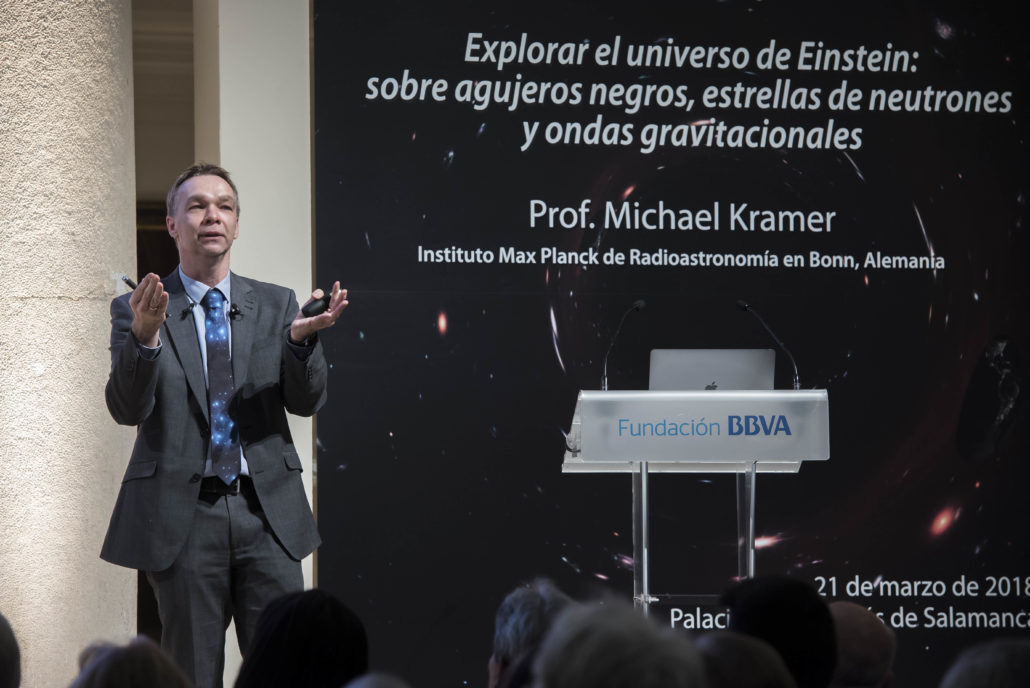El profesor y director del Instituto Max Planck de Radioastronomía ofreció la conferencia “Explorar el universo de Einstein: Sobre agujeros negros, estrellas de neutrones y ondas gravitacionales” invitado por la Fundación BBVA.

El año en que la física despide a Stephen Hawking, uno de los principales expertos mundiales en agujeros negros, puede ser también el que consiga, por fin, ver un agujero negro. O, para ser más precisos, su horizonte de sucesos, el punto de no retorno para la materia engullida por uno de estos sumideros cósmicos de los que ni siquiera puede escapar la luz. El año pasado, ocho radiotelescopios de todo el planeta, incluido el Telescopio de 30 metros en Pico Veleta, en Sierra Nevada (Granada), observaron conjuntamente durante semanas el agujero negro en el centro de la Vía Láctea, Sagitario A*, y sus resultados serán publicados este año. Este es uno de los proyectos qué más tiempo ocupan actualmente a Michael Kramer, director del Instituto Max Planck de Radioastronomía, en Bonn (Alemania), que el miércoles 21 de marzo intervino en el ciclo La ciencia del cosmos, la ciencia en el cosmos de la Fundación BBVA, en Madrid.
Como explica Kramer, el proyecto internacional Event Horizon Telescope (EHT) “trata de sacar una foto al agujero negro supermasivo en el centro de nuestra galaxia”. No desvelará el misterio de lo que ocurre dentro del agujero negro, pero comprobará una de las predicciones de la teoría: “La Relatividad General describe la gravedad como la geometría, la curvatura, del espacio-tiempo; en el centro de un agujero negro el espacio-tiempo se curva demasiado, y nuestra física y muestras matemáticas no pueden describir ese estado”, señala Kramer. “Pero se ha postulado que todo agujero negro debe tener un horizonte de sucesos, que bloquea nuestra visión al interior del agujero y que es la distancia del centro del agujero a la que la luz ya no puede escapar”.
Kramer analizó todas estas cuestiones en su conferencia, titulada Explorar el universo de Eisntein: sobre agujeros negros, estrellas de neutrones y ondas gravitacionales. El astrofísico recuerda que “el universo está lleno de objetos fascinantes en condiciones que nunca seremos capaces de reproducir en los laboratorios terrestres”. Observando estos objetos es posible investigar si las leyes físicas que funcionan en la Tierra son iguales en todas partes, incluso alrededor de los agujeros negros. “En otras palabras, ¿la teoría de la gravedad de Einstein es nuestra palabra final con respecto a la comprensión de la gravedad, o estaba Einstein equivocado?”, se preguntó el astrofísico en su conferencia.
Kramer es un experto a la hora de poner a prueba a la Teoría de la Relatividad General. Él y sus colaboradores han sometido a esta teoría a su test más exigente hasta la fecha, comprobando que sus predicciones logran efectivamente describir uno de los objetos más difíciles de imaginar para la mente humana: un púlsar doble. Einstein salió indemne de la prueba, pero Kramer hubiera preferido lo contrario. Un error en las predicciones de la Relatividad General “hubiera sido una excelente noticia”, dice; “las desviaciones de la teoría son un indicio de que queda mucho por aprender, y encontrarlas sería muy emocionante”.
El astrofísico no oculta su propia fascinación por los púlsares, un tipo de objeto para el que sus descubridores, hace cinco décadas, llegaron a considerar una posible naturaleza extraterrestre –medio en serio, medio en broma, lo apodaron LGM, siglas en inglés de Little Green Men, Pequeños Hombrecillos Verdes-.
Resumen de la conferencia ‘Explorar el universo de Einstein’:
Faros cósmicos
“Empecé con los púlsares simplemente porque mi director de tesina buscaba un estudiante en esa área”, dice Kramer. “Pero cuanto más aprendía sobre ellos, más me fascinaban. Ocupan lo que la ciudad de Madrid, pero pesan un 40% más que el Sol. Son faros cósmicos –siempre me han gustado los faros–, y nos envían pulsos de radiación con la regularidad de un reloj atómico. Son muy útiles para la física, observándolos podemos estudiar fenómenos físicos muy diferentes”. En esencia, los púlsares son estrellas muertas que en su día explotaron como supernovas. En ese tipo de explosión las estrellas implosionan –colapsan hacia su propio centro–, y el resultado es un cadáver estelar muy denso, cuya intensísima fuerza de gravedad puede llegar a formar un agujero negro.
Los púlsares son, en ese sentido, un estadio anterior a los agujeros negros: su gravedad es muy alta, pero no tanto como para tragar la luz y dar la impresión, como en el caso de los agujeros negros, de que perforan el espacio-tiempo. A cambio, los púlsares tienen sus peculiaridades. Una es que rotan velozmente, entre decenas y miles de veces cada segundo, mientras emiten un chorro de radiación; cuando con cada giro ese chorro apunta a la Tierra, los telescopios terrestres reciben un pulso de energía, como un faro.
La precisión de los púlsares es tal, que los de milisegundo marcan el tiempo mejor que los relojes atómicos humanos –de ahí que el primero descubierto, en 1967, hiciera pensar en una civilización extraterrestre–. Por eso mismo pueden usarse para experimentos de precisión exquisita, como los que ponen a prueba la Teoría de la Relatividad General.
Hoy se conocen unos 1.800 púlsares, y se sabe que muchos tienen un objeto compañero que gira a su alrededor. En 2003 Kramer y otros astrofísicos descubrieron a solo 1.500 años luz de la Tierra uno muy especial, porque no era un púlsar, sino dos: un púlsar doble. Ambos objetos orbitan uno en torno al otro cada 2,4 horas; el púlsar principal tarda solo 22.7 milisegundos en rotar sobre sí mismo, y su compañero, cada 2.77 segundos. Costó identificarlos porque a veces se eclipsan –solo se ve una de las señales–, pero la confirmación de su doble naturaleza fue un hito para la astrofísica. Los científicos enseguida pensaron en usarlos para someter a la Teoría de la Relatividad General a su examen más exigente en condiciones de gravedad intensa.
Universo “fascinante”
“En efecto, logramos [hacer estas pruebas] solo tres años después del descubrimiento del púlsar doble”, explica Kramer. “Nuestros resultados confirmaron la validez de la Relatividad General con una exactitud del 0.05%, lo que supone con mucho la mayor precisión jamás obtenida en condiciones de alta gravedad”.
Se ha podido determinar que ambos púlsares se acercan el uno al otro 7 milímetros cada día, porque pierden energía al emitir ondas gravitacionales. No es posible detectar directamente estas ondas, pero sí estimar sus características con medidas de los púlsares más precisas aún. Kramer y sus colaboradores lo están intentando: “Podemos probar diferentes aspectos, como las características de las ondas gravitacionales, la propagación de la luz en campos gravitacionales, el hecho de que los relojes corren más despacio en la proximidad de cuerpos muy masivos, la curvatura del espacio-tiempo… Para cada uno de estos efectos la relatividad general hace una predicción, que podemos comparar con nuestros datos de manera muy precisa”.
Para los físicos, es muy importante encontrar los fenómenos que no logra predecir la teoría, porque esos límites son la vía por donde buscar nuevas respuestas. “Los físicos creyeron en la gravedad de Newton durante cientos de años; pero se encontraron desviaciones, y eventualmente Einstein propuso la Relatividad General”, explica Kramer. “Entender la gravedad tal como la describe la Relatividad General ha sido una revolución, y nos ha permitido encontrar o entender nuevos objetos, como los agujeros negros”.
“El universo es fascinante, y ya hemos conseguido saber mucho sobre él, aunque aún queda mucho por entender. Somos afortunados por vivir en este momento, con muchos experimentos y herramientas a nuestro alcance. En el futuro va a ser apasionante comprobar de manera definitiva si Einstein tenía razón o estaba equivocado”, concluyó Kramer al final de su conferencia.
Ver la conferencia completa en español: https://www.youtube.com/watch?v=swJiQUCW8ug
Watch the complete talk in English: https://www.youtube.com/watch?v=1M95lKBw_UE&feature=youtu.be
Originalmente publicado por la Fundación BBVA. Puedes ver el artículo completo aquí.
Astrophysicist Michael Kramer explains the project designed to “see” the supermassive black hole at our galaxy’s center
Fundacíon BBVA, March 21 2018
Michael Kramer visited Madrid on Wednesday, March 21 to give a talk titled “Exploring Einstein’s Universe: About Black Holes, Neutron Stars and Gravitational Waves” as part of the the BBVA Foundation lecture series Science of the Cosmos, Science in the Cosmos.
The year that physics lost Stephen Hawking, one of its leading experts in black holes, could also be the year that humanity finally gets to “see” one. Or, to be more precise, its event horizon, the point of no return for the matter devoured by these cosmic sinkholes that retain even light. Last year, eight radio telescopes from all round the planet, including the 30-meter Pico Veleta telescope in Sierra Nevada (Granada), were trained for a week on the black hole at the core of the Milky Way, known as Sagittarius A*, with results due out some time this year. This is one of the projects currently occupying Michael Kramer, Director of the Max Planck Institute for Radio Astronomy in Bonn (Germany), who visited the BBVA Foundation’s Madrid headquarters on Wednesday, March 21, as the latest speaker in its Science of the Cosmos, Science in the Cosmos lecture series.
The Event Horizon Telescope (EHT) project, Kramer explains, “is trying to take a ‘photo’ of the supermassive black hole in the center of our galaxy.” It will not solve the mystery of what goes on inside the black hole, but will at least verify one of the predictions enshrined in current theory: “General Relativity describes gravity as the geometry or curvature of spacetime. In the center of a black hole, spacetime becomes too curved, and our mathematics and physics are incapable of describing such a state,” Kramer explains. “But what we have postulated is that every black hole must have an event horizon, which blocks our view from the outside to the inside and is also the distance from the center where light cannot escape anymore.”
Kramer discussed these questions in his talk, titled “Exploring Einstein’s Universe: About Black Holes, Neutron Stars and Gravitational Waves.” For the German astrophysicist, “The Universe is full of fascinating objects with conditions that we will never be able to reproduce in terrestrial laboratories.” But through astronomical observations, we can test whether the fundamental laws of nature that we determine here on Earth are the same everywhere – even around black holes. “In other words, is Einstein’s theory of gravity our final word with regards to the understanding of gravity,” he asks himself, “or was Einstein maybe wrong?”
Kramer has a distinguished track record when it comes to testing the Theory of General Relativity. He and his team have subjected the theory to its toughest test yet, to see if its predictions can properly describe an object – the double pulsar – that is barely within the grasp of our human imagination. Einstein passed the test, but Kramer would have preferred the opposite outcome. A failure in the predictions of General Relativity “would have been excellent news,” he affirms, “because finding deviations is a hint that there is more to be learned, and that would be very exciting.”
The study of cosmic lighthouses
The scientist is frank about his own fascination for pulsars, a kind of cosmic object discovered some fifty years ago, whose first observers speculated that it could be of extraterrestrial origin – only half in jest, they gave it the initials LGM, standing for “little green men.”
“I started work on pulsars for no other reason than that my thesis supervisor was looking for a student in that area,” Kramer recalls now. “But the more I learned the more I was fascinated, and I never left the field. Pulsars are the size of Madrid, but weigh 40% more than the Sun. They are cosmic lighthouses (I always liked lighthouses!) and they send us radiation pulses with the regularity of an atomic clock. They are of great use in physics, because by observing them, we can study many different physical phenomena.”
Pulsars are essentially dead stars that at one point exploded as supernovas. In this kind of explosion, the star itself actually implodes – collapses towards its own center – resulting in a dense stellar corpse whose immense gravitational force can end up forming a black hole. Pulsars are, in this respect, the last stage before a black hole: their gravity is extremely strong but not strong enough to swallow light and appear as if they were piercing spacetime in the way that black holes do. However they do have their peculiarities. One is that they spin extremely fast, between tens and thousands of times a second, while emitting a stream of radiation; each time this stream sweeps past the Earth, ground-based telescopes pick up an energy pulse, like the beam of a lighthouse.
So precise is their rotation that millisecond pulsars can measure time more accurately than human-built atomic clocks – that is why when first discovered, in 1967, it was thought that they could be the product of some extraterrestrial civilization. It is this quality that makes them suitable for ultra-precise experiments, like those designed to test the Theory of General Relativity.
A “fascinating” universe
Some 1,800 pulsars have been recorded to date, and we know that many of them are circled by a companion star. In 2003 Kramer and other astrophysicists discovered a very special example just 1,500 light years from Earth, because it was not one pulsar, but two: a double pulsar. The two objects orbited each other every 2.4 hours, with the first rotating on its axis every 22.7 milliseconds, and the second with a spin period of 2.77 seconds. This binary system was hard to spot because the bodies would eclipse each other – with only one signal visible – but when its existence was confirmed it marked a huge milestone in astrophysics. At once scientists seized on double pulsars as a way to subject General Relativity to its hardest test yet in the presence of a strong gravitational field.
“We got these tests running just three years after the double pulsar’s discovery,” Kramer relates. “And our results confirmed the validity of General Relativity at the 0.05% level, which is by far the best precision yet achieved for the strong-field regime.”
The two pulsars have been shown to be moving seven millimeters closer every day, due to the energy they lose emitting gravitational waves. Although there is no way to detect these waves directly, we can get an idea of their characteristics by undertaking even more precise pulsar measurements. Kramer and his colleagues are trying to do just that: “We can test many different aspects, among them the characteristics of gravitational waves, the propagation of light in gravitational fields, the fact that clocks go slower near massive bodies, the curvature of spacetime, etc. For each of these effects, general relativity makes a prediction and we can compare those with our data to high precision.”
For physicists, it is important to identify phenomena that the theory fails to predict, because they determine in which directions new answers must be sought. “Physicists believed in Newton’s gravity for hundreds of years. Deviations were then observed and eventually Einstein proposed General Relativity. Understanding gravity as described by General Relativity was a revolution that allowed us to find and understand new things, among them black holes.”
For Kramer, the main message to take away from his talk is that “the Universe is a fascinating place, and we have understood a lot already. But there are still challenges ahead. Happily, we live in fortunate times, with great experiments, methods and tools available to help with the task.”
About Michael Kramer
Michael Kramer is Director of the Max Planck Institute for Radio Astronomy (MPIfR) in Bonn (Germany) and a member of the Scientific Council of the European Research Council (ERC). He studied physics in Cologne and Bonn, earning a PhD in 1995. After a few years on the MPIfR staff, he moved to the University of California, Berkeley (United States), and from there to the University of Manchester (United Kingdom), where he became Professor of Astrophysics in 2006. In 2009, he was appointed Director back at the MPIfR. His main research interest is the study of fundamental physics using radio astronomy, in particular radio pulsars. A member of the team which received the Descartes Prize of the European Union in 2005, he also won the Marcel-Grossmann Award in 2009 and the Academy Award of the Berlin-Brandenburg Academy of Science in 2010. In 2013 he was awarded the Herschel Medal of the Royal Astronomical Society in the UK.
Watch the complete talk in English: https://www.youtube.com/watch?v=1M95lKBw_UE&feature=youtu.be
This article is published on the website of Fundacíon BBVA and can be found here.





